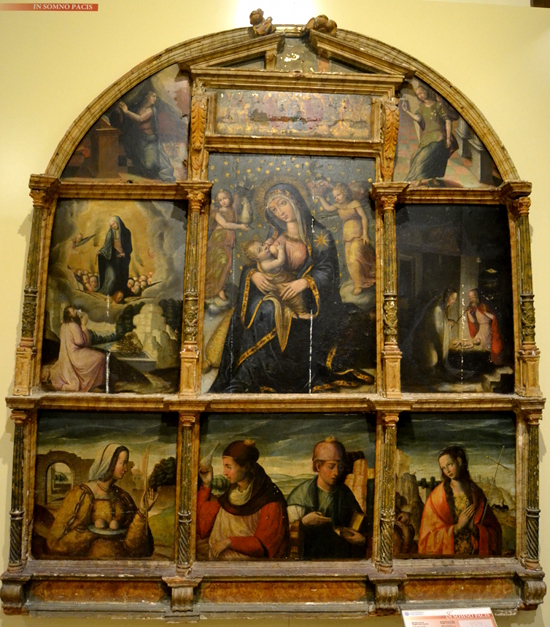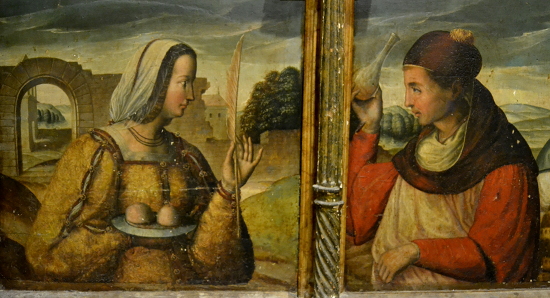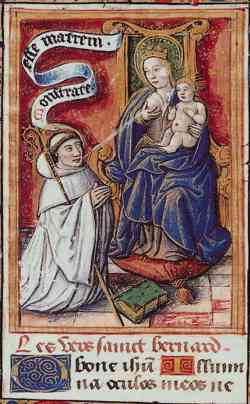The Altarpiece of the Virgin of the Milk, the Breast of Spanish Renaissance Art

In a previous post about Salamanca, Spain, I talked about Salamanca cathedral’s rich collection of Medieval and Renaissance art, inlcuding a splended retablo and some rare wall paintings. Like many cathedrals in this country, it also houses a small museum of some of its treasures. One of the most unusual items is the Altarpiece of the Virgin of the Milk.
It dates to the second half of the 16th century and was produced by an unknown artist. At its center is a breastfeeding Virgin, “La Virgen de la Leche,” part of a tradition of such depictions dating back to at least the 12th century. She is surrounded by other images detailing her Bible story and also related religious figures. Above is her Coronation. On the upper left is the Annunciation, and to the upper right the Archangel Gabriel. To the left is the Assumption of Mary, to the right the Birth and Adoration of Jesus.
It gets weirder in the lower register, with Saint Agatha on the lower left offering a plate of breasts to Saints Cosmas and Damien. On the lower right Saint Margaret rounds out the picture.


Saint Agatha is the patron saint of diseases of the mammary glands and patron saint of nursemaids, an important job in those days. Saints Cosmas and Damien are plague doctors and patron saints of children. Saint Margaret is the patron saint of difficult births. Thus this odd sequence of figures begins to make sense. Pregnant or nursing women can pray to this altarpiece and connect with saints that cover all aspects of their dangerous situation.
Milk had a deeper meaning in Medieval and Renaissance imagery. It was seen as a sort of processed blood. Therefore the milk of the Virgin Mary could stand in for the blood of Jesus, reinforcing her role as the Co-Redemtrix, a role that grew in prominence throughout the period.
The most radical depiction of this idea comes from the miracle of St. Bernard of Clairvaux, a 12th century Cistercian abbot who in 1146 was praying in Speyer Cathedral when the Virgin Mary appeared nursing the infant Jesus. The infant moved aside and Mary shot milk into Bernard’s mouth.
Other tales say that she shot it in his eye in order to cure his partial blindness. St. Bernard had long preached that the faithful should pray to Mary and that she was his personal mediatrix with God, so such a miracle was in keeping with his theology.
Thus while bare-breasted virgins and spouts of human milk may seem odd to the modern eye, they did have a place in the iconography of the time. One wonders, however, if these paintings elicted some adolescent snickering in church, and whether the clergy of the time, who were the subject of numerous scandals for keeping mistresses, might have been reading something a bit more secular into the images.
Sean McLachlan is the author of the post-apocalyptic Toxic World series and several other titles, including his action series set in World War One, Trench Raiders. His historical fantasy novella The Quintessence of Absence, was published by Black Gate. Find out more about him on his blog and Amazon author’s page.
All photos copyright Sean McLachlan.
St. Agatha offering her breasts on a plate is actually not an uncommon image, as you are probably aware. You also often see St. Lucy offering her eyeballs on a plate; my 5yo daughter’s middle name is Luz (Lucy), and this pleases her to no end. I usually try to avoid the picture of St. Agatha when looking in the saints book with my kids, however. One thing at a time.
Somewhat incongruously, I’m reminded of the recent Mad Max movie, in which breast milk plays a prominent role.